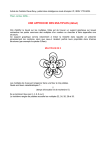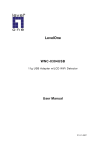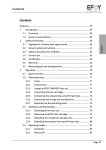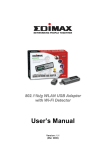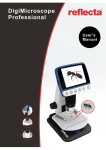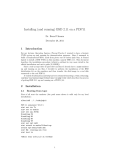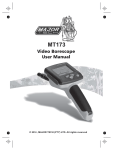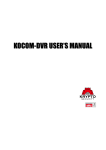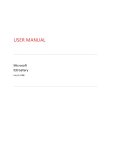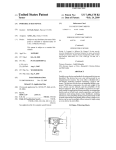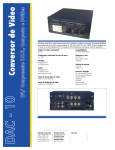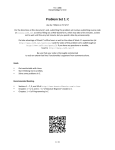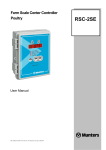Download slides - FAFNER
Transcript
Outline Introduction Basics Operation Programming TI vs. HP Technology/packaging Batteries Buying Conclusion The programmable pocket calculator TI-59 Bernd Ulmann [email protected] Vintage Computer Festival Europe 2007 29th April – 1st May 2007 Munich Bernd Ulmann [email protected] The programmable pocket calculator TI-59 Outline Introduction Basics Operation Programming TI vs. HP Technology/packaging Batteries Buying Conclusion 1 Introduction 2 Basics 3 Operation 4 Programming 5 TI vs. HP 6 Technology/packaging 7 Batteries 8 Buying 9 Conclusion Bernd Ulmann [email protected] The programmable pocket calculator TI-59 Outline Introduction Basics Operation Programming TI vs. HP Technology/packaging Batteries Buying Conclusion Setting the stage On May 24th, 1977, Texas Instruments introduced the TI-59 programmable pocket calculator – one of the greatest programmable calculators ever: Bernd Ulmann [email protected] The programmable pocket calculator TI-59 Outline Introduction Basics Operation Programming TI vs. HP Technology/packaging Batteries Buying Conclusion Highlights With a price of 299.95 USD at the time of its introdcution, the TI-59 was an instant success. Its only competitor at this time was HP’s flagship, the HP-67. With 960 bytes, the TI-59 has about four times as much RAM as the HP-67. The TI-59 is significantly faster than the HP-67. Like the HP-67 the TI-59 features a builtin magnetic card reader/writer which allows to store 480 bytes on the two sides of a single card. The TI-59 features plug-in ROM modules containing libraries of programs and functions. The TI-59 is the most powerful pocket calculator with an seven segment LED display ever built. Bernd Ulmann [email protected] The programmable pocket calculator TI-59 Outline Introduction Basics Operation Programming TI vs. HP Technology/packaging Batteries Buying Conclusion Display The display of the TI-59 consists of 12 digits of which 10 are used to actually display numeric values. The leftmost digit displays a stylized letter ”C” when the calculator is currently calculating something. Bernd Ulmann [email protected] The programmable pocket calculator TI-59 Outline Introduction Basics Operation Programming TI vs. HP Technology/packaging Batteries Buying Conclusion Keyboard The keyboard contains 45 keys which allow access to more than 100 functions using a shift key 2nd and an inverse function key INV. Bernd Ulmann [email protected] The programmable pocket calculator TI-59 Outline Introduction Basics Operation Programming TI vs. HP Technology/packaging Batteries Buying Conclusion Keyboard The rather unique feature of providing an inverse function key INV aviods a cluttered keyboard and makes operation intuitive: The INV key can be used in front of many operations yielding their inverse function: INV ln x will result in the calculation of e x . This concept extends to programming – INV SBR will not jump to a subroutine but instead return from one! Bernd Ulmann [email protected] The programmable pocket calculator TI-59 Outline Introduction Basics Operation Programming TI vs. HP Technology/packaging Batteries Buying Conclusion ROM modules One of the most successful features of the TI-59 is the availability of plug-in ROM modules containing up to 5000 program steps each. Every calculator came with the mighty Master Library Module installed which contained lots of useful programs and functions: Bernd Ulmann [email protected] The programmable pocket calculator TI-59 Outline Introduction Basics Operation Programming TI vs. HP Technology/packaging Batteries Buying Conclusion ROM modules These ROM modules proved to be a key to the instant success the TI-59 had in the market place. Apart from quite a lot of different modules manufactured by Texas Instruments themselves (they even had a leisure library module) there were a couple of companies developing modules to turn the TI-59 into a special handheld device for some particular (arcane) application. Some examples are: USMC Harrier VSTOL/REST Calculator: This module supported Harrier pilots. A special Allianz insurance module which turned the TI-59 into a insurance agent tool. The Navigatronic module containing functions for marine navigational tasks. And lots more. . . Bernd Ulmann [email protected] The programmable pocket calculator TI-59 Outline Introduction Basics Operation Programming TI vs. HP Technology/packaging Batteries Buying Conclusion RAM The main memory of the TI-59 consists of four integrated circuits TMC0598 holding 1920 bits each making up a total of 960 bytes in the machine. This is about four times more than the HP-67 featured and two times more than the smaller cousin of the TI-59, the TI-58, supports. The memory is divided into two parts: Program memory and variable memory holding values during calculations. The initial configuration is 480 program steps and 60 variable registers. One program step occupies one byte while a numeric value requires eight bytes. Bernd Ulmann [email protected] The programmable pocket calculator TI-59 Outline Introduction Basics Operation Programming TI vs. HP Technology/packaging Batteries Buying Conclusion Magnetic cards One of the most important features of the TI-59 is the built-in magnetic card reader/writer. A single card can hold 2 times 240 bytes, so the complete memory contents may be copied to two cards like this: Bernd Ulmann [email protected] The programmable pocket calculator TI-59 Outline Introduction Basics Operation Programming TI vs. HP Technology/packaging Batteries Buying Conclusion Power supply and batteries Like most of its competitors, the TI-59 gets its power normally from a custom rechareably battery pack which mounts in the back of the calculator. Operation of the card reader is only possible with charged batteries (and not with the power supply only) since it draws more than 200 mA during operation. The battery packs were the only major drawback of the TI-59 since they only allowed for one or two hours of continuous calculation when fresh, while recharging took hours. In addition to this the batteries tended to die early with replacement parts getting more and more difficult to obtain. Bernd Ulmann [email protected] The programmable pocket calculator TI-59 Outline Introduction Basics Operation Programming TI vs. HP Technology/packaging Batteries Buying Conclusion AOS The TI-59 features an input method called AOS, the Algebraic Operating System which allows the user to enter most calculations in the same way into the calculator they are normally written down. AOS knows about operator precedence, supports up to six levels of parentheses and proves to be a really powerful input method. From a technological point of view, AOS is way more advanced than the RPN technique used by HP in its (early) (pocket) calculators. Bernd Ulmann [email protected] The programmable pocket calculator TI-59 Outline Introduction Basics Operation Programming TI vs. HP Technology/packaging Batteries Buying Conclusion AOS examples The following example shows how to enter a simple formula using AOS: Performing a simple calculation ( 2 + 3 ) * 4 - 5 * 6 + 7 = Some calculations require a value to be entered several times as in the calculation 2 + 1.234567 ∗ 1.234567. Unlike other calculators, the TI-59 allows to repeat the number entered last by pressing the CE-key: Reusing a value 2 + 1.234567 * CE = Bernd Ulmann [email protected] The programmable pocket calculator TI-59 Outline Introduction Basics Operation Programming TI vs. HP Technology/packaging Batteries Buying Conclusion Using registers Some complicated calculations can be significantly simplified by employing registers for storing and retrieving of values between calculation steps. To store a value currently being displayed (such a value is said to be in the display register) into a register (register numbers range from 0 to 59 using normal memory partition) can be done using the STO function: STO 12 will store the current value into register 12. To recall this particular value you can enter RCL 12. Bernd Ulmann [email protected] The programmable pocket calculator TI-59 Outline Introduction Basics Operation Programming TI vs. HP Technology/packaging Batteries Buying Conclusion Using library programs As mentioned earlier, there is plethora of programs supplied in form of exchangable ROM modules. Most of these programs can be used as stand alone applications while it is possible to use them as subroutines for own programs. A program in a ROM module is identified by its program number. To run a program with number 1, the following steps are necessary: 2nd PGM 01. Calculate factorial of 10 using the Master Library Module 2nd PGM 16 10 A C Bernd Ulmann [email protected] The programmable pocket calculator TI-59 Outline Introduction Basics Operation Programming TI vs. HP Technology/packaging Batteries Buying Conclusion Introduction to Programming Programming the TI-59 is simple and straight forward: A program consists of a number of steps entered on the keyboard which will be repeated automatically at every program run. In addition to the normal calculator functions, the TI-59 has provisions for conditional branching, looping and subroutine calling. The programming model of the TI-59 feels very natural for someone used to program non-Forth systems. :-) Bernd Ulmann [email protected] The programmable pocket calculator TI-59 Outline Introduction Basics Operation Programming TI vs. HP Technology/packaging Batteries Buying Conclusion Entering programs To write a program, the learn mode has to be entered by pressing the LRN-key. This will result in a display as shown below: The three leftmost digits show the current address, where the instruction to be entered will be stored, while the two rightmost digits show the decimal representation of the instruction itself. Bernd Ulmann [email protected] The programmable pocket calculator TI-59 Outline Introduction Basics Operation Programming TI vs. HP Technology/packaging Batteries Buying Conclusion A simple programming example Let us write a small program incrementing the value shown in the display by one, displaying the result for a short period of time and then repeating this action over and over again: Counting loop 000 001 002 003 004 + 1 = PAUSE RST Add one to the current value Display the new value for a short moment Reset the program counter thus looping Bernd Ulmann [email protected] The programmable pocket calculator TI-59 Outline Introduction Basics Operation Programming TI vs. HP Technology/packaging Batteries Buying Conclusion Entering and running the program 1 Enter learn mode by pressing LRN. 2 Enter the program step by step by pressing the appropriate keys on the keyboard. 3 After entering the last step, press LRN again to leave the learn mode. 4 Since the program counter will now point to address 005 it has to be reset manually by pressing RST before starting the program execution by pressing R/S. 5 To halt a running program, press R/S again. Bernd Ulmann [email protected] The programmable pocket calculator TI-59 Outline Introduction Basics Operation Programming TI vs. HP Technology/packaging Batteries Buying Conclusion Using GTO This loop is very crude since it resets the program counter after every iteration. Using the goto command GTO a more precise control is possible: Counting loop 000 001 002 003 004 + 1 = PAUSE GTO 000 Add one to the current value Display the new value for a short moment Jump to location 000 Bernd Ulmann [email protected] The programmable pocket calculator TI-59 Outline Introduction Basics Operation Programming TI vs. HP Technology/packaging Batteries Buying Conclusion Using labels instead of addresses The TI-59 supports labels as the destination of branch instruction instead of real addresses. This has the advantage of being easier to use than real addresses at the cost of being way more slowly: Counting loop 000 002 003 004 005 006 LBL A + 1 = PAUSE GTO A Define a label called A Add one to the current value Display the new value for a short moment Jump to location 000 Bernd Ulmann [email protected] The programmable pocket calculator TI-59 Outline Introduction Basics Operation Programming TI vs. HP Technology/packaging Batteries Buying Conclusion The keys A–E and A’–E’ The top row of keys on the TI-59 is denoted by letters A to E and A’ to E’ (shifted with 2nd). Pressing such a key will cause a jump to the next label with corresponding name, so pressing A will start program execution in the currently active program at label A. Not only these special names can be used as label names, instead even operators like = may serve as label names! All programs from the various ROM modules make frequent use of this technique. Bernd Ulmann [email protected] The programmable pocket calculator TI-59 Outline Introduction Basics Operation Programming TI vs. HP Technology/packaging Batteries Buying Conclusion Working with magnetic cards Writing magnetic cards: Using the magnetic card reader/writer it is possible to store programs and data on magnetic cards for later use. A magnetic card has two sides capable of holding up to 240 bytes each, so it is possible to store the entire memory contents using two cards. Therefore the memory is divided into four banks running from 1 to 4. To write a card you have to enter the number of the bank to be saved into the display register and then press 2nd WRITE. Then insert the card into the reader/writer. After writing the card the number of the bank written will be displayed. If it is blinking, the write operation was unsuccessful. Bernd Ulmann [email protected] The programmable pocket calculator TI-59 Outline Introduction Basics Operation Programming TI vs. HP Technology/packaging Batteries Buying Conclusion Working with magnetic cards Reading magnetic cards is simpler: In the easiest case just insert the card into the reader/writer. After completion of the read operation the number of the bank which was filled with the card’s contents is displayed. If this number blinks, the read operation was unsuccessful. It is possible to redirect card contents to other banks than they were written from – more information about this can be found in the user manual of the TI-59. Bernd Ulmann [email protected] The programmable pocket calculator TI-59 Outline Introduction Basics Operation Programming TI vs. HP Technology/packaging Batteries Buying Conclusion An example program: The Ulam conjecture Legend tells that Stanislaw Ulam some day came up with the following algorithm: 1 Take a positive integer as a start value. 2 If it is even, divide it by two. 3 If it is odd, multiply it by 3 and add one. 4 Repeat the steps beginning at step 2. Ulam speculated that this algorithm will yield the value 1 for every positive integer used as a starting point1 . In the following a short program will be shown which implements the algorithm above printing not only the various values during the run but also the numbers of steps necessary to reach 1. 1 This is still an unproven conjecture! Bernd Ulmann [email protected] The programmable pocket calculator TI-59 Outline Introduction Basics Operation Programming TI vs. HP Technology/packaging Batteries Buying Conclusion The N 2 /3N + 1-problem 000 002 004 005 006 008 010 011 012 013 015 017 020 022 023 Bernd Ulmann [email protected] The programmable pocket calculator TI-59 LBL STO CP 0 STO RCL / 2 = STO INV X=T RCL * 3 A 00 02 00 01 INT 041 00 024 025 026 027 029 031 032 033 034 035 038 041 043 0046 048 + 1 = STO 00 OP 22 PAUSE 1 = X=T 046 GTO 008 RCL 01 GTO 027 RCL 02 R/S Outline Introduction Basics Operation Programming TI vs. HP Technology/packaging Batteries Buying Conclusion TI vs. HP or AOS vs. RPN There is an ongoing and probably never ending debate between TI and HP proponents about the ideal way of operating a calculator. While TI people favor and algebraic input style, the HP fraction features the use of RPN2 . Both techniques have advantages and disadvantages and it is mainly a question of personally liking which method will serve best for someone. 2 Reverse Polish Notation Bernd Ulmann [email protected] The programmable pocket calculator TI-59 Outline Introduction Basics Operation Programming TI vs. HP Technology/packaging Batteries Buying Conclusion AOS vs. RPN A small example may show the basic difference between AOS and RPN. Let us suppose that the result of (2 + 3) · 4 has to be determined: AOS: ( 2 + 3 ) * 4 = (eight keystrokes) RPN: 2 ENTER 3 + 4 * (six keystrokes) Using an algebraic input method is nearer to conventional mathematical notation than the RPN variant, while the latter normally requires fewer keystrokes than the former. Learning to transform normal algebraic formulas into RPN is fairly easy but still requires some abstraction. Bernd Ulmann [email protected] The programmable pocket calculator TI-59 Outline Introduction Basics Operation Programming TI vs. HP Technology/packaging Batteries Buying Conclusion System overview The main parts of a TI-59 are a TMC0501 4 bit processor surrounded by four TMC0598 RAMs holding 1920 bits each, an interface chip for the magnetic card reader/writer, the necessary clock generation circuitry and a switching power supply generating three MOS compatible voltages. Bernd Ulmann [email protected] The programmable pocket calculator TI-59 Outline Introduction Basics Operation Programming TI vs. HP Technology/packaging Batteries Buying Conclusion System overview Bernd Ulmann [email protected] The programmable pocket calculator TI-59 Outline Introduction Basics Operation Programming TI vs. HP Technology/packaging Batteries Buying Conclusion Dissecting a TI-59 Back covers open Bernd Ulmann [email protected] The programmable pocket calculator TI-59 Outline Introduction Basics Operation Programming TI vs. HP Technology/packaging Batteries Buying Conclusion Dissecting a TI-59 Interior Bernd Ulmann [email protected] The programmable pocket calculator TI-59 Outline Introduction Basics Operation Programming TI vs. HP Technology/packaging Batteries Buying Conclusion Dissecting a TI-59 The card reader/writer Bernd Ulmann [email protected] The programmable pocket calculator TI-59 Outline Introduction Basics Operation Programming TI vs. HP Technology/packaging Batteries Buying Conclusion Dissecting a TI-59 The keys Bernd Ulmann [email protected] The programmable pocket calculator TI-59 Outline Introduction Basics Operation Programming TI vs. HP Technology/packaging Batteries Buying Conclusion Dissecting a TI-59 The keyboard Bernd Ulmann [email protected] The programmable pocket calculator TI-59 Outline Introduction Basics Operation Programming TI vs. HP Technology/packaging Batteries Buying Conclusion An old battery pack Most vintage battery packs have deteriorated (decomposed) during the last up to 30 years. The pack shown below was removed from a TI-59 obtained at an online auction. Bernd Ulmann [email protected] The programmable pocket calculator TI-59 Outline Introduction Basics Operation Programming TI vs. HP Technology/packaging Batteries Buying Conclusion Removing and replacing the old batteries It is crucial that no battery packs will be left installed in a calculator being not used on a regular basis to avoid (sometimes extreme) damage on the calculator. The following pictures show a way to replace an old battery pack on a TI-59 with modern NiMH rechargeable batteries3 . Never throw away the plastics enclosure of the battery pack since it will be needed to construct a new battery pack! Normally you will want to preserve the battery contact strips – I did not do this since the calculator was already missing the flexible contact strips on its main board. 3 Please note that I take no responsibility for any damage to you or your equipment when you attempt to do something like this yourself! Bernd Ulmann [email protected] The programmable pocket calculator TI-59 Outline Introduction Basics Operation Programming TI vs. HP Technology/packaging Batteries Buying Conclusion The battery holder The picture below shows the empty battery holder after removing the damaged original batteries. Bernd Ulmann [email protected] The programmable pocket calculator TI-59 Outline Introduction Basics Operation Programming TI vs. HP Technology/packaging Batteries Buying Conclusion The new batteries Bernd Ulmann [email protected] The programmable pocket calculator TI-59 Outline Introduction Basics Operation Programming TI vs. HP Technology/packaging Batteries Buying Conclusion The new batteries in place Bernd Ulmann [email protected] The programmable pocket calculator TI-59 Outline Introduction Basics Operation Programming TI vs. HP Technology/packaging Batteries Buying Conclusion Field report Having run a TI-59 with such a replacement battery pack for a couple of months now, the following results can be stated: The overall runtime using NiMH batteries has increased to something between 5 and 10 hours compared with 1 to 2 hours using the original NiCd batteries. Due to the low internal resistance, usage of the card reader/writer is possible even after long calculator runs. Loading an empty battery pack takes about 12 hours! Bernd Ulmann [email protected] The programmable pocket calculator TI-59 Outline Introduction Basics Operation Programming TI vs. HP Technology/packaging Batteries Buying Conclusion Buying a TI-59 From time to time TI-59 calculators turn up at flea markets or at online auctions. Before buying one some things should be kept in mind: If the calculator powers up, try to perform the selftest program of the Master Library Module: Selftest 2nd PGM 01 SBR = If the calculator does not power on at all it might be caused by a defective battery pack. Do not despair – it might be repairable and at least the calculator can serve as a spare parts holder to salvage another TI-59. Bernd Ulmann [email protected] The programmable pocket calculator TI-59 Outline Introduction Basics Operation Programming TI vs. HP Technology/packaging Batteries Buying Conclusion Buying a TI-59 Never store calculators with their batteries installed. Keep the batteries in sealable plastics bags away from the calculators. Normally it is not a good idea to run a calculator without its batteries, but with the external power supply connected! HP calculators will most probably be destroyed by doing this, while TI-59s will normally survive it but generate random results and errors. Flakey keys can be sometimes cured by placing a thin mat of foam rubber between the keyboard and the printer circuit board thus increasing the pressure against the keys. Bernd Ulmann [email protected] The programmable pocket calculator TI-59 Outline Introduction Basics Operation Programming TI vs. HP Technology/packaging Batteries Buying Conclusion Conclusion The TI-59 is one of the finest pocket calculators every made. When you take good care of a TI-59 it will last nearly for ever and be a dependable friend. Its AOS is far superior to other data/program entry methods of contemporary calculators. The TI-59 is the climax in the development of pocket calculators using seven segment LED displays. Have fun with your TI-59 and take good care of it! Bernd Ulmann [email protected] The programmable pocket calculator TI-59















































